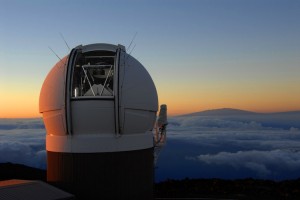Welcome to the PS1SC blog
January 18th, 2011 by ps1scblogHello and welcome to Pan-STARRS 1 Science Consortium blog. Pan-STARRS is a planned system of four telescopes (funded by the US Air Force) that will repeatedly survey the sky visible from Hawai’i. The first of these eyes on the sky, Pan-STARRS 1 (PS1), began operations on Haleakala on Maui in May 2010. While its primary purpose is to scan the skies for asteroids that could one day hit the Earth, it will also discover comets, study the coolest, faintest neighbours of our Sun, search for planets around other stars, explore the structure of our Galaxy and its siblings, seek out distant black holes and exploding stars and even probe the mysterious dark matter and dark energy that make up over 90% of our universe. This groundbreaking telescope is operated by the Pan-STARRS 1 Science Consortium consisting of the Institute for Astronomy, the University of Hawai’i, the Max Planck Institute for Astronomy, Heidelberg and the Max Planck Institute for Extraterrestrial Physics, Garching, The Johns Hopkins University, the University of Durham, the University of Edinburgh, the Queen’s University Belfast, the Harvard-Smithsonian Center for Astrophysics, the Las Cumbres Observatory Global Telescope Network and the National Central University of Taiwan and also receives funding from NASA.
Pan-STARRS 1, a 1.8m telescope, comes equipped with the worlds largest digital camera which has 1.4 billion pixels (over 250 times the number of pixels in an iPhone’s camera). This along with the telescope’s design allows it to observe with a three degree field of view (six full moons across), meaning it can cover the sky visible from Hawai’i 20 times per year.
Over the next few months we’ll be bringing you posts outlining the exciting science PS1 will be uncovering in the years ahead. That isn’t to say that it hasn’t yielded any scientific discoveries yet, in September last year PS1 data was used to identify a potentially hazardous asteroid which subsequently came close to the Earth in October. Here’s the ever telegenic Rob Jedicke being interviewed for the local news in Honolulu about this asteroid.



